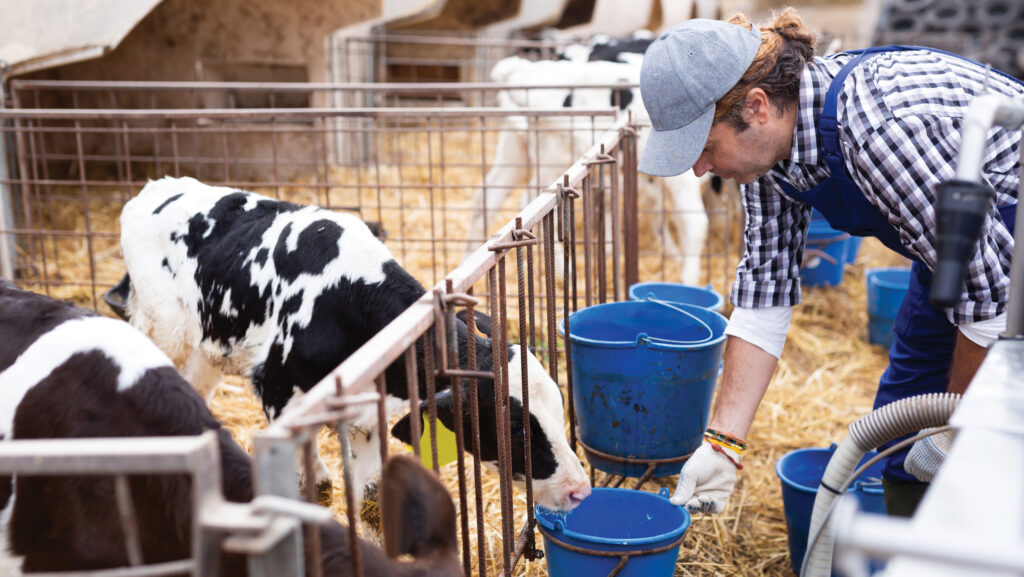Why calf starter feed is important for weaning
 © Adobe Stock
© Adobe Stock Offering calves a starter concentrate from day one – plus access to clean water – is critical for rumen development and, ultimately, avoiding a post-weaning dip in growth rates.
Even when the nutrient content of calf starter has been selected to meet the herd’s growth targets, intake potential is not guaranteed.
Palatability, texture and hygiene standards at feeding all have a big influence, according to US calf specialist Dr Jim Quigley of Calf Notes Consulting.
See also: Advice on feeding calves for good rumen development
While the amounts eaten will be minimal in the first week of life, calves will be curious and begin to play with the feed.
“They won’t eat very much, but you are getting them to learn that’s what they need to do – that it is food. So, it is a period of education,” says Jim.
He explains that concentrates are formulated to supply non-fibre carbohydrates (NFCs), which include starches, sugars and some pectins.

© Adobe Stock
When digested, they supply the short-chain fatty acids propionate and butyrate, which drive rumen development.
“Calf starter is the key vehicle to help a calf transfer from being a monogastric to a ruminant,” he stresses.
Rumen development
The sooner this learning process begins, the better, he adds, because a calf is ready to be weaned (from a metabolic perspective) only when it has consumed a cumulative 15kg of NFC.
This figure is a “proxy” for sufficient rumen development to wean the calf.
Yet globally, dairy industry guidelines for weaning are still “all over the place”, based on age, size, intake, or a combination of these factors, says Jim.
HIs view is that a calf is biologically ready to be weaned when its digestive and metabolic mechanisms can replace liquid nutrients with those from dry feed – without a reduction in availability of nutrients.
“We can’t let the calf post-weaning miss out on the energy and protein it needs for maintenance and growth.
“After weaning, a large part of that energy and protein needs to come from rumen fermentation,” he says.

Jim Quigley © Jim Quigley
This means it has to be developed and functioning.
“It is possible to wean a calf prior to consumption of 15kg of NFC.
“However, our data suggest the animal will be less efficient at obtaining energy from the calf starter and may grow more slowly until rumen development reaches sufficient maturity,” he adds.
With so many different feeding regimes and products available, Jim recommends online modelling tools to help work out weaning dates based on a farm’s specific diet.
Then the task is to find ways to induce the calf to eat high-quality calf starter.
Key characteristics to encourage calves include a consistent product (calves do not like variability) and a complex, textured starter, rather than pellets, which they seem to prefer.
Palatability of starter feed
Research has shown that starter palatability is enhanced when there is less than 14% dry matter of fat, no more than 5% rapemeal and preferably 5% molasses.
Fines (small particles) usually occur because of poor pellet integrity or handling, and any starter with more than about 5% of fines is a problem as it leads to refusals.
Jim suggests using a Penn State separator to assess quality.
“Don’t let the calf run out of starter. Change it daily and keep it dry – from weather and water buckets,” he says.
Provision of water
Often, a missing link in concentrate feeding is recognising the importance of water. This drives starter intakes and must be managed, he explains.
“A rule of thumb is calves drink 2 litres for every 1kg of dry matter [DM] intake before weaning and 4 litres/kg DM after.”
He cites one study that showed offering water from birth gets the rumen process going and results in an increased hip height and body length at 42 days of age, compared with offering water at 17 days of age.
“Water should be available ad-lib to all calves from birth, changed daily, and cleaned [at least] weekly.
“In hot climates, it may be supplemented with diluted electrolytes to stimulate water intake.
“In cold climates, water should be managed so that buckets do not freeze, and make sure calves have [access to] water for more than two hours morning and evening.”
Role of forage
Contrary to perception, however, forage in early life slows rumen development because it contains neutral detergent fibre.
“Calves in early life have very low ad-lib hay intakes. The role of forage is to stabilise the rumen and reduce the risk of acidosis,” says Jim, who suggests as a compromise a dry total mixed ration that combines about 5-10% DM of chopped forage and 90-95% starter.
Volume of milk replacer
Ultimately, there is a trade-off from feeding high volumes of milk replacer to maximise pre-weaning growth rates. He points out that concentrate intakes are naturally lower because calves tend to eat to an “energy endpoint”. When more energy is supplied by milk, the calf’s body requires less energy from dry feeds.
He advises that feeding rates of 8-12 litres/day will, therefore, delay starter intake and rumen development, so weaning age needs to be later than when feeding lower milk rates. Furthermore, step-down weaning is critical to promote concentrate intakes as milk feeding tails off.
• Dr Jim Quigley was speaking as part of a recent Total Dairy webinar.
Calf starters: more information
- Calf Notes –Modelling tools that allow accurate
prediction of cumulative 15kg of non-fibre
carbohydrate (NFC) intakes - Calf Growth Prediction System from Calf Notes
CalfSim from the University of
Vermont
